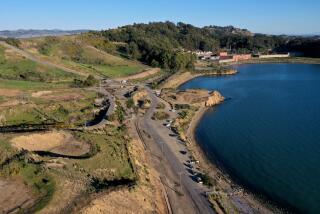Bakersfield Rallies to Save Piece of Its Past
- Share via
BAKERSFIELD — The landmark Bakersfield sign stood as a sentinel from the days when the only car air conditioning was what Central Valley residents call 6-0-2 cooling, or 60 mph with two windows open.
Arching over four lanes of old California 99, the sign welcomed the hot and weary who had braved the often grueling trip over the Grapevine from Los Angeles to a palm tree-rich oasis of motels and restaurants in the 1950s and early 1960s.
But despite its status as an icon of California highway culture, the sign was threatened with demolition when state transportation officials determined that it would not withstand a bad earthquake.
Worried residents mounted an effort to save the landmark, a cause joined by country singer Buck Owens, who this month helped move a scaled-down version of the sign--incorporating the old letters--to a spot near his Crystal Palace nightclub along the newer 99.
“The common man just likes the sign. Lord knows, it ain’t no big cultural thing,” Owens told an appreciative crowd at the club on a recent evening. “It symbolizes this great city of Bakersfield to me. It’s always been like an old friend.”
Before there was an Interstate 5, before there was the new 99 freeway with no stoplights at all, there was old 99 cutting through San Joaquin Valley towns and cities.
Bakersfield’s stretch of 99 was called Union Avenue, and the sign there was one of the biggest landmarks along the entire route.
It was a time when businesses depended on neon to lure people in off highways, and the owners of the Bakersfield Inn--the fanciest place in town in 1949--built the sign to cover a pedestrian walkway connecting the inn’s two wings.
“I worked at a honky-tonk here in town called the Blackboard every night, and five days a week I’d drive to L.A. to play in the recording studios,” said Owens, who moved to Bakersfield in 1951. “Each time when I came along, I saw the old sign. I knew when I saw the sign I was getting close to home.”
But the highway moved west in 1963, and the long decline of Union Avenue began. Motels have been torched by arsonists in recent years, and police regularly bust prostitutes and their customers there.
The Bakersfield sign, with its familiar cobalt blue letters, endured, and was featured in numerous television shows and movies, including “Every Which Way but Loose” with Clint Eastwood. The sign was highlighted in a 1987 video when Owens and Dwight Yoakum rerecorded “Streets of Bakersfield.”
In 1995, state transportation officials began talking about tearing the sign down. Locals kicked off a campaign to save it but were short on cash. Owens, best known from his days hosting “Hee Haw” on television, stepped in earlier this year to help.
The city chipped in $10,000, and other contributors gave smaller amounts. Electricians and other contractors donated labor. Owens is expecting his share to be around $170,000.
The old sign was torn down several weeks ago. The new, smaller version was installed outside the Crystal Palace, just off the Buck Owens Boulevard exit of the 99 freeway. At night, the yellow background and the blue letters create the same eerie glow that was the sign’s trademark.
For Owens, it was a golden opportunity to save a piece of the city’s past and promote his club at the same time.
“It seems pretty popular around here,” said Owens, whose media empire includes three radio stations in Bakersfield, a newspaper shopper and half ownership of 165 stations in the Real Country Radio Network. “I’ll tell you right now, I could run for dogcatcher and I’d get it.”
The only sour notes on the project seem to be sounding from the sign’s old haunt, where residents see the move as further abandonment of Union Avenue.
“Buck Owens could have gotten his own sign,” said Josephine Pratt as she bought lunch recently at a Der Wienerschnitzel that was so close to the old sign it was featured in Eastwood’s movie. “He’s got enough money. If they really wanted to save it, they could have done it here.
“I moved here in 1957. I remember how it was lit up so pretty. I’m really going to miss seeing that sign,” she said.
Jeff Nickell, lead curator at the Kern County Museum, called the effort to save the sign “extremely unusual” for the city. “We have a pretty strong history of tearing things down, not saving them,” he said.
“One important aspect of this whole project is that its original purpose is being maintained,” he said. “The reason they built it in the first place was because it was old 99, to show people they had really arrived in Bakersfield. The way it is being redone, it accomplishes the same thing.”
More to Read
Sign up for Essential California
The most important California stories and recommendations in your inbox every morning.
You may occasionally receive promotional content from the Los Angeles Times.













